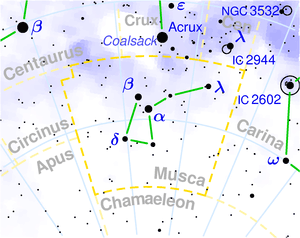|
|
Musca ( Latin: fly) is one of the minor southern constellations. The constellation was one of twelve constellations created by Pieter Dirkszoon Keyser and Frederick de Houtman between 1595 and 1597, and it first appeared in Johann Bayer's Uranometria of 1603. Notable objects The soft X-ray transient Nova Muscae 1991 is a binary object consisting of a star and a black hole. During the 1991 outburst which led to its discovery, radiation was produced through a process of positron annihilation. Musca also contains the unusual planetary nebula NGC 5189, located about 3,000 light years from earth. Its uniquely complex structure resembles a miniature crab nebula. Also within the constellation is the Hourglass Nebula (MyCn 18) at a distance of 8,000 light years. The comparatively old globular cluster NGC 4833 near Delta Muscae is 21,200 light years distant and somewhat obscured by dust clouds near the galactic plane. The globular cluster NGC 4372 near Gamma Muscae is fainter and likewise partially obscured by dust, but spans more arc minutes. Named Stars * Star....Name......Origin....Meaning * μ.......Butain....Arabic....little belly * 35......Krittika..? History Musca, under its original name Apis – the Bee, was introduced in the 17th century by Johann Bayer to fill the previously uncharted area around the southern pole. It was unknown to classical and early cultures, and they produced no mythology concerning it. In 1752 Nicolas Louis de Lacaille renamed it to Musca Australis, the Southern Fly – Australis, since it counterparted the now discarded constellation of Musca Borealis composed of a few stars in Aries. Today the name is simply Musca. [1] Citations 1. ^ Shane Horvatin – Obsolete Constellations: Apis References * Ian Ridpath and Wil Tirion (2007). Stars and Planets Guide * Thomas Wm. Hamilton, Useful Star Names, Holbrook, NY, Viewlex, 1968. Links
Retrieved from "http://en.wikipedia.org/"
|
|
||||||||||||||||||||||||||||||||||||||||||||||||||||
